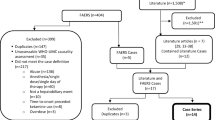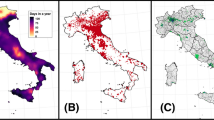Abstract
Purpose
Gastroschisis incidence has increased over the past decade nationally and in Hawaii. Pesticides have been implicated as potential causative factors for gastroschisis, and use of restricted use pesticides (RUPs) is widespread in Hawaii. This study was conducted to characterize gastroschisis cases in Hawaii and determine whether RUP application correlates with gastroschisis incidence.
Methods
Gastroschisis patients treated in Hawaii between September, 2008 and August, 2015 were mapped by zip code along with RUP use. Spatial analysis software was used to identify patients’ homes located within the pesticide application zone and agricultural land use areas.
Results
71 gastroschisis cases were identified. 2.8% of patients were from Kauai, 64.8% from Oahu, 16.9% from Hawaii, 14.1% from Maui, and 1.4% from Molokai. RUPs have been used on all of these islands. 78.9% of patients lived in zip codes overlapping agricultural land use areas. 85.9% of patients shared zip codes with RUP-use areas.
Conclusion
The majority of gastroschisis patients were from RUP-use areas, supporting the idea that pesticides may contribute to the development of gastroschisis, although limited data on specific releases make it difficult to apply these findings. As more RUP-use data become available to the public, these important research questions can be investigated further.

Similar content being viewed by others
References
Agopian AJ, Langlois PH, Cai Y, Canfield MA, Lupo PJ (2013) Maternal residential atrazine exposue and gastroschisis by maternal age. Matern Child Health J 17:1768–1775
Chabra S, Gleason CA (2005) Gastroschisis: embryology, pathogenesis, epidemiology. NeoReviews 6:e493-e499
Corey KM, Hornik CP, Laughon MM, McHutchison K, Clark RH, Smith PB (2014) Frequency of anomalies and hospital outcomes in infants with gastroschisis and omphalocele. Early Hum Dev 90:421–424
De la Vega A, Lopez-Cepero R (2009) Seasonal variations in the incidence of some congenital anomalies in Puerto Rico based on the timing of conception. P R Health Sci J 28:121–125
Frolov P, Alali J, Klein MD (2010) Clinical risk factors for gastroschisis and omphalocele in humans: a review of the literature. Pediatr Surg Int 26:1135–1148
Hemminki K, Saloniemi I, Kyyronen P, Kekomaki M (1982) Gastroschisis and omphalocele in Finland in the 1970s: prevalence at birth and its correlates. J Epidemiol Community Health 36:289–293
Shariff F, Peters PA, Arbour L, Greenwood M, Skarsgard E, Brindle M (2015) Maternal and community predictors of gastroschisis and congenital diaphragmatic hernia in Canada. Pediatr Surg Int 31:1055–1060
Yazdy MM, Mitchell AA, Werler MM (2014) Maternal genitourinary infections and the risk of gastroschisis. Am J Epidemiol 180:518–525
Winchester PD, Huskins J, Yung J (2008) Agrochemicals in surface water and birth defects in the United States. Acta Paediatr 98:664
Yazdy MM, Werler MM, Anderka M, Langlois PH, Vieira VM (2015) Spatial analysis of gastroschisis in Massachusetts and Texas. Ann Epidemiol 25:7–14
Yazdy MM, Werler MM, Feldkamp ML, Shaw GM, Mosley BS, Vieira VM (2015) The national birth defects Prevention Study. Spatial analysis of gastroschisis in the National Birth Defects Prevention Study. Birth Defects Res A Clin Mol Teratol 103:544–553
Van Dorp DR, Malleis JM, Sullivan BP, Klein MD (2010) Teratogens inducing congenital abdominal wall defects in animal models. Pediatr Surg Int 26:127–139
Castilla EE, Mastroiacovo P, Oriole IM (2008) Gastroschisis: international epidemiology and public health perspectives. Am J Med Genet C Semin Med Genet 148C:162–179
Forrester MB, Merz RD (2006) Comparison of trends in gastroschisis and prenatal illicit drug use rates. J Toxicol Environ Health A 69(13):1253–1259
Kirby RS, Marshall J, Tanner JP, Salami JL, Feldkamp ML, Marengo L, Meyer RE, Druschel CM, Rickard R, Kucik JE (2013) Prevalence and correlates of gastroschisis in 15 states, 1995 to 2005. Obstet Gynecol 122:275–281
Parker ST, Mai CT, Canfield MA, Rickard R, Wang Y, Meyer RE, Anderson P, Mason CA, Collins JS, Kirby RS, Correa A (2010) Updated national birth prevalence estimates for selected birth defects in the United States, 2004–2006. Birth Defects Res A Clin Mol Teratol 88:1008–1016
Mattix KD, Winchester PD, Scherer LRT (2007) Incidence of abdominal wall defects is related to surface water atrazine and nitrate levels. J Pediatr Surg 42:947–949
Waller SA, Paul K, Peterson SE, Hitti JE (2010) Agricultural-related chemical exposures, season of conception, and risk of gastroschisis in Washington state. Am J Obstet Gynecol 202:241e1–e6
http://hdoa.hawaii.gov/pi/files/2016/03/HAWAII-RUP-SALES-SUMMARY-2015.pdf. 5 (2016)
https://www.epa.gov/pesticide-worker-safety/restricted-use-products-rup-report. 5 (2016)
https://www.census.gov/2010census. 10 (2016)
Van Gelder MMHJ, Rogier A, Donders T, Devine O, Roeleveld N, Reefhuis J (2014) Using Bayesian modeles to assess the effects of under-reporting of cannabis use on the association with birth defects, National Birth Defects Prevention Study, 1997–2005. Paediatr Perinat Epidemiol 28:424–433
Author information
Authors and Affiliations
Corresponding author
Rights and permissions
About this article
Cite this article
Souther, C., Puapong, D.P., Woo, R. et al. Possible etiologies of increased incidence of gastroschisis. Pediatr Surg Int 33, 1209–1213 (2017). https://doi.org/10.1007/s00383-017-4166-4
Accepted:
Published:
Issue Date:
DOI: https://doi.org/10.1007/s00383-017-4166-4




